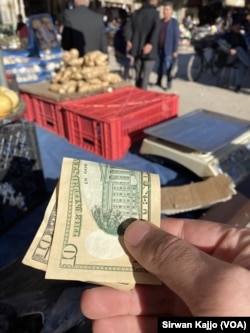With northeastern Syria’s economy severely shattered by 13 years of conflict, most business owners and store owners are content with just a few customers a day. But these customers would definitely be happier if they paid in US dollars.
“If you don’t have Syrian money, no problem, I’ll accept any dollars you have,” a teenage fruit vendor in the Kurdish-majority city of Qamishli told U.S. News as he tried to sell his product. sound.
“If you buy these strawberries, I will take the $10 note and give you the change in Syrian currency,” added the boy, who did not give his name.
Across the region, the Syrian pound has experienced unprecedented depreciation over the past decade. Currency devaluation is one of the many economic consequences of the civil war that has raged since 2011.
As of April 4, the exchange rate of 1 dollar to Syrian pound on Qamishli’s black market was 14,000. Before the war broke out, one dollar was worth about 50 Syrian pounds.
“With the depreciation of the Syrian pound, the U.S. dollar has become an alternative currency in northeastern Syria,” said Mohammed Hafeed Khalil, a lecturer in economics and accounting at Rojava University in Qamishli.
“The U.S. dollar is now the de facto currency and helps stabilize the local economy,” he told VOA. “In places where hyperinflation has been affecting the economy for years, everyone is happy to transact in U.S. dollars, whether it’s big business owners, shopkeepers, street vendors or local customers.”
Bave Ciwan, a grocery store owner in the Qamishli indoor market, said it is convenient to use U.S. dollars in daily transactions.
“We buy goods in dollars, so it’s natural to sell in dollars,” he told VOA, adding, “The exchange rate of the Syrian lira [or pound] It changes every day, so sometimes it doesn’t make sense to sell in Syrian currency. ”
The grocer said that while not every customer has U.S. dollars, most store owners would rather conduct business in U.S. dollars “because then we don’t have to keep raising prices with every change in the exchange rate.”
Much of northeastern Syria is controlled by the Syrian Democratic Forces (SDF), a Kurdish-led military coalition that has been the United States’ main partner in the fight against the Islamic State terror group. The SDF-affiliated autonomous government has governed the area since 2012, when Syrian government forces withdrew to fight rebels elsewhere in the country.
While much of the Kurdish-controlled region is politically and militarily outside the control of Syrian President Bashar Assad’s government, its economy remains largely tied to the central government, particularly over currency issues.
“As an autonomous government, we do not have a policy of economic dollarization because we are part of Syria,” said Hadiya Ali, co-chairman of the Economic and Agricultural Committee of the Autonomous Government of Northern and Eastern Syria.
“However, we have realized that the use of U.S. dollars in the market can actually help the local population get through these difficult times and stabilize the economy of northeastern Syria. So while we do not have a policy of adopting the U.S. dollar as the currency unit, we will do so whenever we have Contributing to the economic stability of our region, there will be no restrictions on the use of U.S. dollars in the market,” Ali said.
Khalil also said that compared with other parts of Syria, the steady flow of dollars into northeastern Syria has liberated and revitalized the local economy.
“While formal dollarization may not be possible in the northeast at the moment, the abundance of dollar bills here contrasts with the legal prohibition on the use of dollars in areas controlled by the Syrian government,” he said. “This gives northeastern Syria an economic advantage, Because the country is still subject to Western sanctions against the government.”
Western governments, including the United States, have imposed significant economic sanctions on Assad’s government over its crackdown on peaceful protesters and crimes against civilians.
More than 90% of Syria’s population lives in poverty; According to the United Nations report Released in March.
This story originated from the Kurdish section of VOA.
Follow us on Google news ,Twitter , and Join Whatsapp Group of thelocalreport.in














